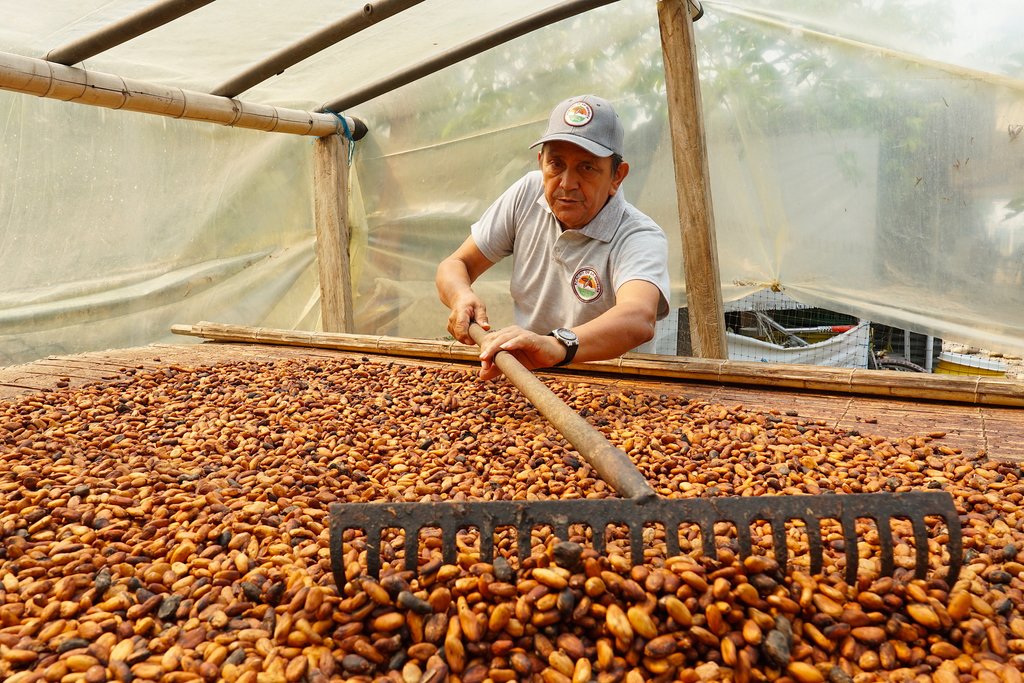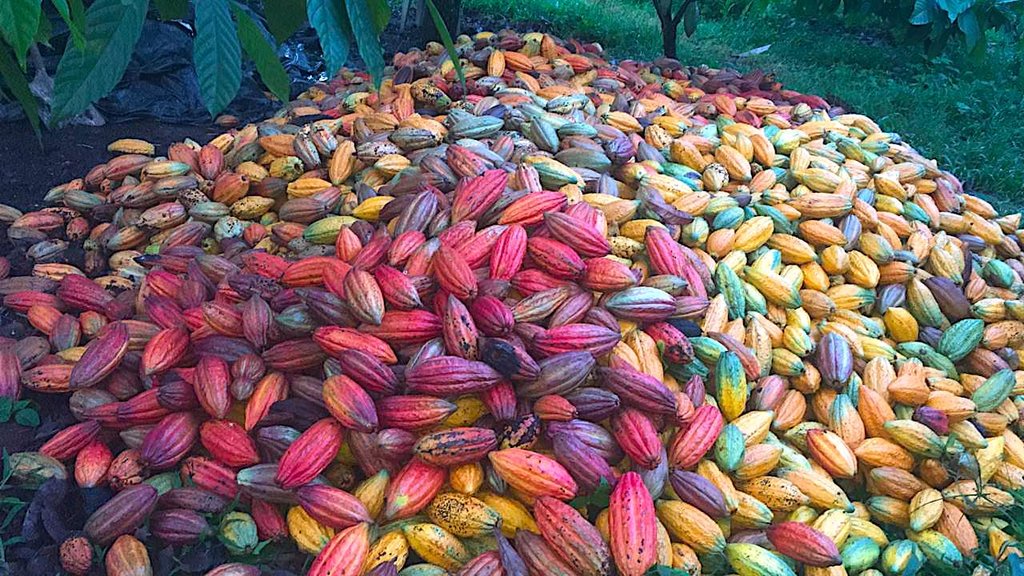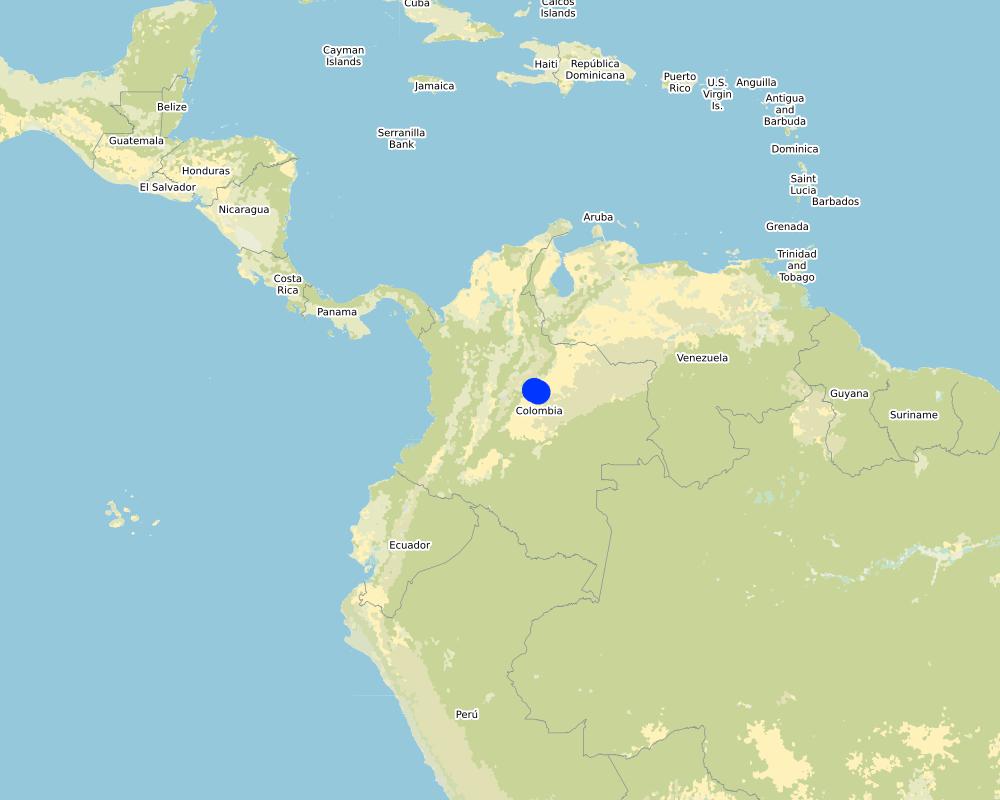Agroforestry system of cacao and gallery forest [哥伦比亚]
- 创建:
- 更新:
- 编制者: Luisa F. Vega
- 编辑者: Hanspeter Liniger
- 审查者: Hanspeter Liniger
cacao
technologies_5763 - 哥伦比亚
查看章节
全部展开 全部收起1. 一般信息
1.2 参与该技术评估和文件编制的资源人员和机构的联系方式
关键资源人
土地使用者:
Martinez Ana Silvia
Maracaibo Farm
哥伦比亚
土地使用者:
Medina Rafael
Maracaibo Farm
哥伦比亚
1.3 关于使用通过WOCAT记录的数据的条件
编制者和关键资源人员接受有关使用通过WOCAT记录数据的条件。:
是
1.4 所述技术的可持续性声明
这里所描述的技术在土地退化方面是否存在问题,导致无法被认为是一种可持续的土地管理技术?:
否
2. SLM技术的说明
2.1 技术简介
技术定义:
Agroforestry system of cacao crop under gallery forest shadow as family agriculture. It is located at the foothill ecosystem of the Andes, in the Cusiana River, Orinoco Watershed, Colombia.
2.2 技术的详细说明
说明:
The agroforestry system of cacao crop planted under gallery forest is a private farmer initiative for family agriculture. The Crop is located in the gallery forest of Pozetas Stream, in the Cusiana River Basin. It is in the Foothill Ecosystem (300m a.s.l.), between the Andean Mountains and the Orinoco Floodable Savanas. Municipality of Tauramena (Casanare), Colombia.
The cacao growths in an area of 4 hectares, being considered small farming, according to the Orinoco Region scales. The cacao density is 1080 plants/hectare and the distance between plants is 3m. In this area, after tree thinning, the forest occupies 30% approximately. Some of the common tree species are Cedrus spp., Ficus spp. and Anadenanthera peregrina, among others.
The purpose of the technology is to use the gallery forest land in a productive way to generate income for the family, while keeping part of the forest and integrate it in the agroforestry as cacao needs some shadow, specially in early growth stage.
Seed germination and seedling preparation, forest thinning and soil improvement with lime and organic fertilizer (rice husk), and finally planting, are the main establishment activities. Then the maintenance activities include cutting weeds, trimming cacao trees and fertilization every 2-3 months.
The cacao crop has produced fruits since the sixth year of being planted (2016) and is harvested every two weeks. It presents two yield peaks, the first one is in May-June and the second one in October-November. However it produces fruits along the year.
This technology provides additional income to the family, while conserving part of the original gallery forest. The more complex and diverse production system might favored pollination and crop health. The technology compared with other land uses around it such as oil palm tree and rice is more sustainable and it is something land users prefer. They also like the value added to the cacao beens by processing their self the cacao beens to produce hand made 100% cacao bars for drinking chocolate.
2.3 技术照片
2.5 已应用该技术的、本评估所涵盖的国家/地区/地点
国家:
哥伦比亚
区域/州/省:
Casanare
有关地点的进一步说明:
Municipality of Tauramena, Rural District of Iquia
具体说明该技术的分布:
- 均匀地分布在一个区域
如果技术均匀分布在一个区域,则指定覆盖的区域(单位为平方千米):
0.04
如果不知道精确的区域,请注明大致覆盖的区域:
- < 0.1 平方千米(10 公顷)
技术现场是否位于永久保护区?:
否
Map
×2.6 实施日期
注明实施年份:
2010
2.7 技术介绍
详细说明该技术是如何引入的:
- 通过土地使用者的创新
注释(项目类型等):
It is a private initiative, introduced by a small farmer family to use the forest. They have use a bank loan to establish the cacao crop.
3. SLM技术的分类
3.1 该技术的主要目的
- 减少、预防、恢复土地退化
- 创造有益的经济影响
3.2 应用该技术的当前土地利用类型
同一土地单元内混合使用的土地::
是
具体说明混合土地使用(作物/放牧/树木):
- 农林业

农田
- 乔木与灌木的种植
乔木和灌木种植 - 指定作物:
- 可可
具体说明:
Permanent along the year.
采用间作制度了吗?:
否
采用轮作制度了吗?:
否

森林/林地
- (半天然)天然森林/林地
(半天然)天然森林/林地:具体说明管理类型:
- 选伐
- Tropical Andean Foothill Forest
树木类型:
- Cedrus species
- Anadenanthera peregrina, Ficus spp.,
以上的树木是落叶树还是常绿树?:
- 常绿
产品和服务:
- 薪材
- 自然灾害防护
- shadow
3.3 由于技术的实施,土地使用是否发生了变化?
由于技术的实施,土地使用是否发生了变化?:
- 是(请在技术实施前填写以下有关土地利用的问题)
同一土地单元内混合使用的土地::
否

森林/林地
- (半天然)天然森林/林地
(半天然)天然森林/林地:具体说明管理类型:
- 非木材森林的利用
- Tropical Andean Foothill Forest
树木类型:
- Cedrus species
- Anadenanthera peregrina, Ficus spp.
以上的树木是落叶树还是常绿树?:
- 常绿
产品和服务:
- 薪材
- 自然保持/保护
- 自然灾害防护
3.4 供水
该技术所应用土地的供水:
- 混合雨水灌溉
注释:
During rainy season (April-November), rain provides enough water for the cacao crop. During dry season (December-March), when there is almost not rain, the cacao is irrigated by channels.
3.5 该技术所属的SLM组
- 农业林学
3.6 包含该技术的可持续土地管理措施

管理措施
- M1:改变土地使用类型
- M5:物种组成的控制/变化
3.7 该技术强调的主要土地退化类型

生物性退化
- Bh:栖息地丧失
- Bq:数量/生物量减少
3.8 防止、减少或恢复土地退化
具体数量名该技术与土地退化有关的目标:
- 防止土地退化
4. 技术规范、实施活动、投入和成本
4.1 该技术的技术图纸
技术规范(与技术图纸相关):
In the agroforestry system of cacao and gallery forest, the cacao trees are planted, having 3 m distance between them. The native forest occupies 30% of the system and provides shadow to the cacao trees. Shadow is important for the good development of cacao, especially in early stages. Additionally the forest increases system complexity, diversity and balance, it increases crop pollination and health. The leaf litter from the cacao and the forest are also an important source of organic matter for soil.
作者:
Diego Orduz and Luisa F. Vega
日期:
27/04/2020
4.2 有关投入和成本计算的一般信息
具体说明成本和投入是如何计算的:
- 每个技术区域
注明尺寸和面积单位:
4 hectares
其它/国家货币(具体说明):
Colombian Pesos
如相关,注明美元与当地货币的汇率(例如1美元=79.9巴西雷亚尔):1美元=:
3750.0
注明雇用劳工的每日平均工资成本:
45000
4.3 技术建立活动
| 活动 | 时间(季度) | |
|---|---|---|
| 1. | Seed germination | Enero |
| 2. | Plant nursery establishment | Febrero |
| 3. | Clear felling of 70% of native forest in the area | Febrero |
| 4. | Sow hole digging | April-May (beginning of rainy season) |
| 5. | Addition of lime and rice husk to the sow hole | April-May (beginning of rainy season) |
| 6. | Cacao seedling planting in field | April-May (beginning of rainy season) |
4.4 技术建立所需要的费用和投入
| 对投入进行具体说明 | 单位 | 数量 | 单位成本 | 每项投入的总成本 | 土地使用者承担的成本% | |
|---|---|---|---|---|---|---|
| 劳动力 | Forest thinning to open cropland | ha | 4.0 | 150000.0 | 600000.0 | 100.0 |
| 劳动力 | Sow hole preparation and seedling planting | ha | 4.0 | 575000.0 | 2300000.0 | 100.0 |
| 植物材料 | Cacao seeds | seed | 5400.0 | 25.0 | 135000.0 | 100.0 |
| 植物材料 | cacao seedlings | seedling | 5000.0 | 500.0 | 2500000.0 | 100.0 |
| 肥料和杀菌剂 | Lime sack | 50 kg | 10.0 | 12000.0 | 120000.0 | 100.0 |
| 肥料和杀菌剂 | Rice husk | container | 1.0 | 400000.0 | 400000.0 | 100.0 |
| 技术建立所需总成本 | 6055000.0 | |||||
| 技术建立总成本,美元 | 1614.67 | |||||
4.5 维护/经常性活动
| 活动 | 时间/频率 | |
|---|---|---|
| 1. | Cutting of weeds, specially around each cacao tree | Every 2 months |
| 2. | Cacao tree trimming | Every 2 months |
| 3. | Fertilization | Every 2-3 months |
| 4. | Harvesting | Every 2 weeks |
4.6 维护/经常性活动所需要的费用和投入(每年)
| 对投入进行具体说明 | 单位 | 数量 | 单位成本 | 每项投入的总成本 | 土地使用者承担的成本% | |
|---|---|---|---|---|---|---|
| 劳动力 | Cutting of weeds, specially around each cacao tree | day | 18.0 | 45000.0 | 810000.0 | 100.0 |
| 劳动力 | Cacao tree trimming | day | 12.0 | 45000.0 | 540000.0 | 100.0 |
| 劳动力 | Fertilization and soil amendment with lime | day | 13.0 | 45000.0 | 585000.0 | 100.0 |
| 劳动力 | Harvesting | day | 24.0 | 45000.0 | 1080000.0 | 100.0 |
| 设备 | Manual tools (e.g. machete, trimmer, shovel) | kit | 1.0 | 150.0 | 150.0 | 100.0 |
| 肥料和杀菌剂 | Lime sack | 50 Kg | 10.0 | 12000.0 | 120000.0 | 100.0 |
| 肥料和杀菌剂 | Fertilizer sack | 50 Kg | 40.0 | 96000.0 | 3840000.0 | 100.0 |
| 技术维护所需总成本 | 6975150.0 | |||||
| 技术维护总成本,美元 | 1860.04 | |||||
4.7 影响成本的最重要因素
描述影响成本的最决定性因素:
The plant material from seeds to seedlings are the highest cos for the technology establishment. Then the fertilization is an important maintenance cost.
5. 自然和人文环境
5.1 气候
年降雨量
- < 250毫米
- 251-500毫米
- 501-750毫米
- 751-1,000毫米
- 1,001-1,500毫米
- 1,501-2,000毫米
- 2,001-3,000毫米
- 3,001-4,000毫米
- > 4,000毫米
有关降雨的规范/注释:
The technology is located between 2000-2200 mm isohyets. The rain season occurs from April to November and dry season from December to March.
注明所考虑的参考气象站名称:
Precipitation map of the Municipality of Tauramena (2015)
农业气候带
- 潮湿的
5.2 地形
平均坡度:
- 水平(0-2%)
- 缓降(3-5%)
- 平缓(6-10%)
- 滚坡(11-15%)
- 崎岖(16-30%)
- 陡峭(31-60%)
- 非常陡峭(>60%)
地形:
- 高原/平原
- 山脊
- 山坡
- 山地斜坡
- 麓坡
- 谷底
垂直分布带:
- 0-100 m a.s.l.
- 101-500 m a.s.l.
- 501-1,000 m a.s.l.
- 1,001-1,500 m a.s.l.
- 1,501-2,000 m a.s.l.
- 2,001-2,500 m a.s.l.
- 2,501-3,000 m a.s.l.
- 3,001-4,000 m a.s.l.
- > 4,000 m a.s.l.
说明该技术是否专门应用于:
- 不相关
关于地形的注释和进一步规范:
The technology takes place in the tradition from the Andes to the Orinoco Floodable Savanas which topography is flat.
5.3 土壤
平均土层深度:
- 非常浅(0-20厘米)
- 浅(21-50厘米)
- 中等深度(51-80厘米)
- 深(81-120厘米)
- 非常深(> 120厘米)
5.4 水资源可用性和质量
地下水位表:
< 5米
地表水的可用性:
好
水质(未处理):
不良饮用水(需要处理)
水质请参考::
地表水
水的盐度有问题吗?:
否
该区域正在发生洪水吗?:
是
规律性:
偶然
5.5 生物多样性
物种多样性:
- 中等
栖息地多样性:
- 中等
5.6 应用该技术的土地使用者的特征
定栖或游牧:
- 定栖的
生产系统的市场定位:
- 商业/市场
非农收入:
- 收入的10-50%
相对财富水平:
- 平均水平
个人或集体:
- 个人/家庭
机械化水平:
- 机械化/电动
性别:
- 女人
- 男人
土地使用者的年龄:
- 老年人
5.7 应用该技术的土地使用者使用的平均土地面积
- < 0.5 公顷
- 0.5-1 公顷
- 1-2 公顷
- 2-5公顷
- 5-15公顷
- 15-50公顷
- 50-100公顷
- 100-500公顷
- 500-1,000公顷
- 1,000-10,000公顷
- > 10,000公顷
这被认为是小规模、中规模还是大规模的(参照当地实际情况)?:
- 小规模的
5.8 土地所有权、土地使用权和水使用权
土地所有权:
- 个人,有命名
土地使用权:
- 个人
用水权:
- 租赁
土地使用权是否基于传统的法律制度?:
否
5.9 进入服务和基础设施的通道
健康:
- 贫瘠
- 适度的
- 好
教育:
- 贫瘠
- 适度的
- 好
技术援助:
- 贫瘠
- 适度的
- 好
就业(例如非农):
- 贫瘠
- 适度的
- 好
市场:
- 贫瘠
- 适度的
- 好
能源:
- 贫瘠
- 适度的
- 好
道路和交通:
- 贫瘠
- 适度的
- 好
饮用水和卫生设施:
- 贫瘠
- 适度的
- 好
金融服务:
- 贫瘠
- 适度的
- 好
6. 影响和结论性说明
6.1 该技术的现场影响
社会经济效应
生产
作物生产
注释/具体说明:
There was not crop production before the SLM
生产区域
注释/具体说明:
There was not a production area before SLM
收入和成本
农业收入
收入来源的多样性
注释/具体说明:
The main income sources are expensive livestock and cacao bars
社会文化影响
SLM/土地退化知识
生态影响
土壤
土壤有机物/地下C
注释/具体说明:
It has not been tested, however it is assumed a soil organic matter increase you to the increased leaf litter added by the caco trees.
6.2 该技术的场外影响已经显现
下游洪水
注释/具体说明:
The different levels of the agroforestry system and the cacao tree density might increase water retention and infiltration. It contributes to reduce down stream flooding during rainy season.
6.3 技术对渐变气候以及与气候相关的极端情况/灾害的暴露和敏感性(土地使用者认为的极端情况/灾害)
渐变气候
渐变气候
| 季节 | 增加或减少 | 该技术是如何应对的? | |
|---|---|---|---|
| 季节性温度 | 旱季 | 增加 | 好 |
6.4 成本效益分析
技术收益与技术建立成本相比如何(从土地使用者的角度看)?
短期回报:
非常消极
长期回报:
非常积极
技术收益与技术维护成本/经常性成本相比如何(从土地使用者的角度看)?
短期回报:
消极
长期回报:
非常积极
6.5 技术采用
- 单例/实验
在所有采用这项技术的人当中,有多少人是自发的,即未获得任何物质奖励/付款?:
- 0-10%
6.6 适应
最近是否对该技术进行了修改以适应不断变化的条件?:
否
6.7 该技术的优点/长处/机会
| 土地使用者眼中的长处/优势/机会 |
|---|
| The technology generates Income along the year and keep us busy. |
| It is a way of having a crop and the gallery forest together. |
| 编制者或其他关键资源人员认为的长处/优势/机会 |
|---|
| The more complex and diverse production system might favored pollination and crop health. |
| The technology compared with other land uses around it such as oil palm tree and rice is more sustainable. |
6.8 技术的弱点/缺点/风险及其克服方法
| 土地使用者认为的弱点/缺点/风险 | 如何克服它们? |
|---|---|
| It takes 6 years to begin to produce, but during the first years it is still requirement all maintenance activities | Planting cacao varieties, which produce fruits in less than 6 years. |
| There is little support for small farmers an entrepreneur initiatives, from public and private institutions, when then do not belong to any project. | By planning the potential occurrence of technologies/ initiatives,FF that is worth to give support, especially from public institutions and plan some resources for it. |
| 编制者或其他关键资源人员认为的弱点/缺点/风险 | 如何克服它们? |
|---|---|
| Gallery forest thinning to open cropland is about 70%, which is a high portion of forest. The more gallery forest is protected, the better buffering for extreme climatic events | Using cacao tree varieties with more shadow tolerance, which let leave more forest percent in the agroforestry system |
7. 参考和链接
7.1 信息的方法/来源
- 实地考察、实地调查
1
- 与土地使用者的访谈
2
- 根据报告和其他现有文档进行编译
(现场)数据是什么时候汇编的?:
22/04/2020
链接和模块
全部展开 全部收起链接
无链接
模块
无模块






